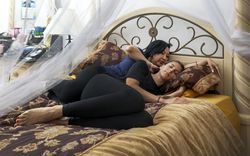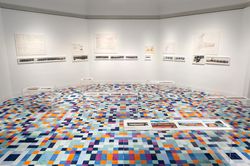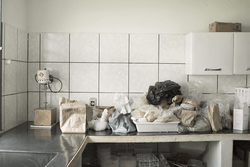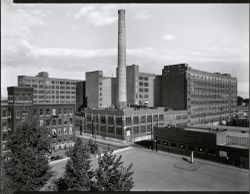dessins
ARCH274842
Description:
Schéma pour la connexion des transformateurs et plan pour la connexion électrique du lave-vaisselle.
1931
Plans d'électricité
Actions:
ARCH274842
Description:
Schéma pour la connexion des transformateurs et plan pour la connexion électrique du lave-vaisselle.
dessins
1931
articles
Réinitialiser le social
1 mars 2021
Salles à câlins, biobanques et maisons de collaboration
Giovanna Borasi sur les nouveaux besoins en architecture
Actions:
articles
1 mars 2021
Réinitialiser le social
ÁbalosHerreros ont construit – ou, plus précisément, ont assemblé – des paysages en juxtaposant de façon sommaire une distribution de « personnages » architecturaux quasi-familiers. Cette méthode pragmatique d’appropriation, mise au point et systématiquement utilisée dans le cadre de leur processus de design, était inédite dans l’architecture des années 1980 en Espagne.(...)
Salle octogonale
23 juillet 2015 au 13 septembre 2015
Paysages de l'hyperréel : Ábalos&Herreros revue par SO – IL
Actions:
Description:
ÁbalosHerreros ont construit – ou, plus précisément, ont assemblé – des paysages en juxtaposant de façon sommaire une distribution de « personnages » architecturaux quasi-familiers. Cette méthode pragmatique d’appropriation, mise au point et systématiquement utilisée dans le cadre de leur processus de design, était inédite dans l’architecture des années 1980 en Espagne.(...)
Salle octogonale
Alors que le climat de la Terre atteint un état d’instabilité constante, la prise de conscience de l’impact du réchauffement planétaire sur les droits de l’homme et l’augmentation des conflits sociaux, ne fait que s’accentuer. Une moindre attention a été accordée aux façons dont la violence politique et l’abus de droits humains, dans le passé comme dans le présent,(...)
Théâtre Paul-Demarais
1 décembre 2016, 18h
Dans les frontières du changement climatique (Vers une politique des droits non humains)
Actions:
Description:
Alors que le climat de la Terre atteint un état d’instabilité constante, la prise de conscience de l’impact du réchauffement planétaire sur les droits de l’homme et l’augmentation des conflits sociaux, ne fait que s’accentuer. Une moindre attention a été accordée aux façons dont la violence politique et l’abus de droits humains, dans le passé comme dans le présent,(...)
Théâtre Paul-Demarais
Série(s)
AP193.S1
Description:
Series 1, Water Flux and Scrambled Flat, 2002-2010, documents the conception and evolution of a project that was originally a farm building and later became a geology and glaciology museum and research center focused on the Swiss Alps. The project was never realized. R&Sie(n) conceptualized Scrambled Flat as an experimental farm. The project goal was to reconcile European Union’s agricultural regulations, imposing a separation between animal and human living, to the community of Évolène traditional way of living, contiguously with animals, benefiting from the resources they offer. As conceived, Scrambled Flat creates an environment where fluidity between the existence of the animals and the humans is materialized. The size of the form is also adapted from a typical local rural house and exploits the heat of the animals and the insulation of the hay. For this project, R&Sie(n) approached the mayor of the community with the design proposition. The mayor then called for a competition, while also changing the program to an ecology museum and research center illustrating the local effects of global warming and the thawing of the Alps. R&Sie(n) won the competition with Water Flux, a reinterpretation of Scrambled Flat. The project was intended to uncover and exorcise the anxieties of ecological disaster, and the principle of flux related to seasonal change and, more broadly, climate change. The firm designed rooms that reproduce the geological and meteorological environment of the high mountains making it visible and experimental, offering refrigerated spaces for art installations and scientific demonstrations. The concept was also to build with the use of new technologies such as digital modelling, point scanning, and computer numerical control (CNC), combined with ancient local knowledge of knocking on trees to decide which specific pines have the best wood for construction. The building is designed to be constructed with local lamellar wood milled by nearby CNC. The resulting parts would be used for the structure, the insulation, the waterproofing and both the interior and exterior finishes. The design includes a grille wrapping the building, reproducing the profile of traditional houses and enclosure and making it possible to hold the snow inside a typo-morphological imprint. Therefore, the transformable envelope of the building reacts to the rhythm of the seasons. In the winter, the structure would appear like a solid cut-out of ice and snow, with cavities similar to those found in glaciers. In the summer, it would resemble piles of stones used in these areas to make borders. A small pool would collect rainwater and supply it to an interior artificial snowmaking system designed for the gallery. Transformation of the water is an integral part of the design. The records contain images of plans, sections, details for the structure of the façade, renderings, plans of the engineered structure, and photographs documenting the conception of the models with the CNC machinery. The Rhino 3D modelling files are also part of the records along with AutoCAD models and a video documenting the process. The records contain two physical models: a smaller polymer model at 1:20 scale representing the whole structure of the building, and a larger 1:1 latch wood fragment representing detail of the structure in its integrality.
2002-2010
Water Flux and Scrambled Flat
Actions:
AP193.S1
Description:
Series 1, Water Flux and Scrambled Flat, 2002-2010, documents the conception and evolution of a project that was originally a farm building and later became a geology and glaciology museum and research center focused on the Swiss Alps. The project was never realized. R&Sie(n) conceptualized Scrambled Flat as an experimental farm. The project goal was to reconcile European Union’s agricultural regulations, imposing a separation between animal and human living, to the community of Évolène traditional way of living, contiguously with animals, benefiting from the resources they offer. As conceived, Scrambled Flat creates an environment where fluidity between the existence of the animals and the humans is materialized. The size of the form is also adapted from a typical local rural house and exploits the heat of the animals and the insulation of the hay. For this project, R&Sie(n) approached the mayor of the community with the design proposition. The mayor then called for a competition, while also changing the program to an ecology museum and research center illustrating the local effects of global warming and the thawing of the Alps. R&Sie(n) won the competition with Water Flux, a reinterpretation of Scrambled Flat. The project was intended to uncover and exorcise the anxieties of ecological disaster, and the principle of flux related to seasonal change and, more broadly, climate change. The firm designed rooms that reproduce the geological and meteorological environment of the high mountains making it visible and experimental, offering refrigerated spaces for art installations and scientific demonstrations. The concept was also to build with the use of new technologies such as digital modelling, point scanning, and computer numerical control (CNC), combined with ancient local knowledge of knocking on trees to decide which specific pines have the best wood for construction. The building is designed to be constructed with local lamellar wood milled by nearby CNC. The resulting parts would be used for the structure, the insulation, the waterproofing and both the interior and exterior finishes. The design includes a grille wrapping the building, reproducing the profile of traditional houses and enclosure and making it possible to hold the snow inside a typo-morphological imprint. Therefore, the transformable envelope of the building reacts to the rhythm of the seasons. In the winter, the structure would appear like a solid cut-out of ice and snow, with cavities similar to those found in glaciers. In the summer, it would resemble piles of stones used in these areas to make borders. A small pool would collect rainwater and supply it to an interior artificial snowmaking system designed for the gallery. Transformation of the water is an integral part of the design. The records contain images of plans, sections, details for the structure of the façade, renderings, plans of the engineered structure, and photographs documenting the conception of the models with the CNC machinery. The Rhino 3D modelling files are also part of the records along with AutoCAD models and a video documenting the process. The records contain two physical models: a smaller polymer model at 1:20 scale representing the whole structure of the building, and a larger 1:1 latch wood fragment representing detail of the structure in its integrality.
Series
2002-2010
dessins
ARCH274506
Description:
Plans et détails de la distribution et de l'alimentation électrique selon les étages, des transformateurs et des disjoncteurs haute-tension.
1956
Plans et détails de la distribution et de l'alimentation électrique selon les étages
Actions:
ARCH274506
Description:
Plans et détails de la distribution et de l'alimentation électrique selon les étages, des transformateurs et des disjoncteurs haute-tension.
dessins
1956
maquettes
AP056.S1.1990.PR04.008
Description:
This model has a lighting component that works with a transformer.
circa 1990
Project model, Canada Life Assurance Building Competition, Toronto
Actions:
AP056.S1.1990.PR04.008
Description:
This model has a lighting component that works with a transformer.
maquettes
circa 1990
Les photographes Clara Gutsche et David Miller proposent leur interprétation du paysage et de l’architecture industriels du véritable site historique en milieu urbain que constitue le Canal de Lachine à Montréal. Ce lieu plus que centenaire reste en effet longtemps à l’abandon malgré le rôle essentiel qu’il joue à l’époque de sa pleine exploitation dans le développement(...)
Salle octogonale
15 juillet 1992 au 22 novembre 1992
Regards sur un paysage industriel : le Canal de Lachine
Actions:
Description:
Les photographes Clara Gutsche et David Miller proposent leur interprétation du paysage et de l’architecture industriels du véritable site historique en milieu urbain que constitue le Canal de Lachine à Montréal. Ce lieu plus que centenaire reste en effet longtemps à l’abandon malgré le rôle essentiel qu’il joue à l’époque de sa pleine exploitation dans le développement(...)
Salle octogonale
dessins
ARCH274098
Description:
Études pour l'emplacement des poutres, colonnes et hourdis de la mezzanine, la chambre des transformateurs et des salles de cour. Cédule de coupe des murs.
circa 1940
Études pour l'emplacement des poutres, colonnes et hourdis de la mezzanine
Actions:
ARCH274098
Description:
Études pour l'emplacement des poutres, colonnes et hourdis de la mezzanine, la chambre des transformateurs et des salles de cour. Cédule de coupe des murs.
dessins
circa 1940
dessins
ARCH3134
Description:
Plan de la salle des transformateurs, de la salle des tableaux électriques (dessin 1123-8) / Canadian Comstock Company, Montréal.
1924
Plan de la salle de transformateur et des panneaux électriques
Actions:
ARCH3134
Description:
Plan de la salle des transformateurs, de la salle des tableaux électriques (dessin 1123-8) / Canadian Comstock Company, Montréal.
dessins
1924



